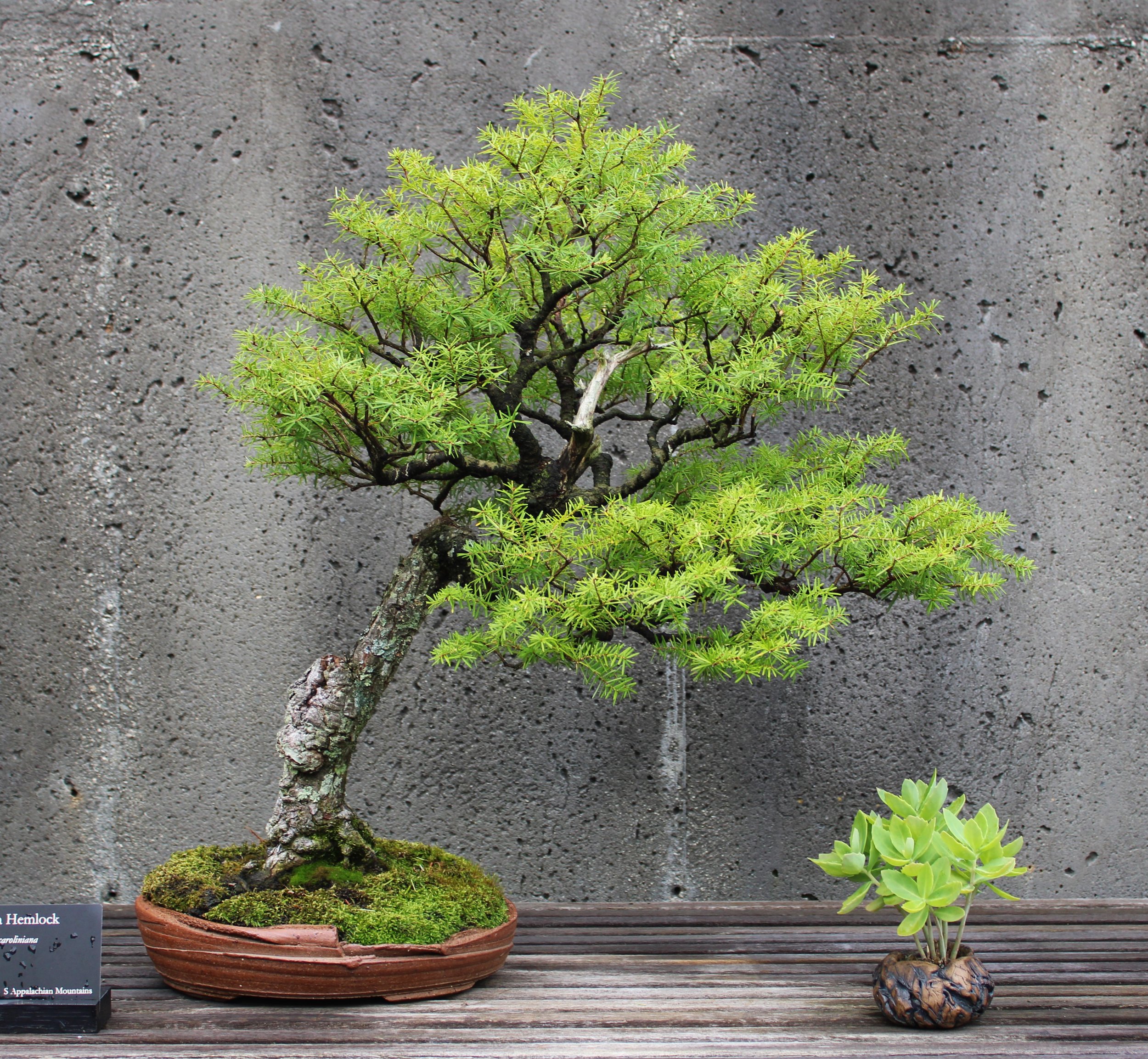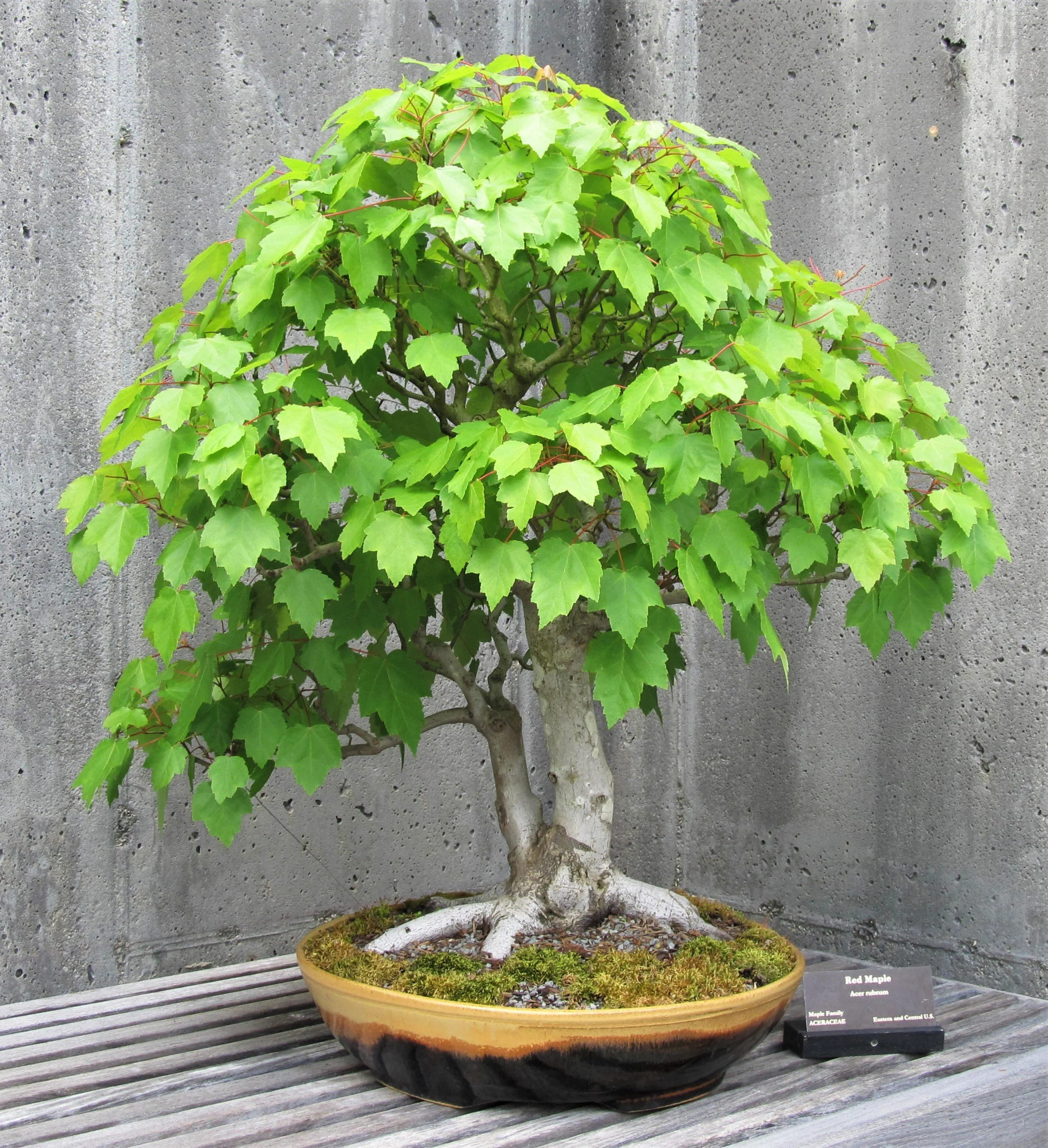Going Native
Note: This entry was written by Arthur Joura for the Natives Exhibit Catalog, published in connection with the 2017 Natives exhibit at The Pacific Bonsai Museum. See publication information at the close of this entry.
Bonsai growers in the United States seem to have an increasing interest in the use of native plants. The same impulse took hold in the gardening and landscape world some time back, and one result is that certain plants, like Joe Pye weed, that were once ripped out by the roots are now cultivated and shown off in world-class gardens. This would seem to suggest that awareness of native plants can lead to a shift of perspective. What might it mean for bonsai?
Any discussion of native plants should begin with a definition of terms. What is a native plant? Is Rocky Mountain juniper a native plant? It is not in North Carolina, where I live. But in a broader sense, defining where I live as the United States, then it is. Is baldcypress a native plant? It is in my home state, but not in the western mountain region of the state, where I live. What about Japanese maple, is that a native plant? Yes it is — in Japan. Every plant is native to somewhere, unless it is a cultivated variety, in which case a plant native to one part of the world might be developed into something a little different in another part of the world. Additionally, plant species can shift their location over time. The fossil record suggests ginkgo trees were once native to North America. It appears the concept of native plant can be a little fuzzy unless we nail down exactly how we are looking at it. If the term native plant can be so ambiguous, why should the idea of using native plants matter? I think the answer lies hidden somewhere beyond the whole issue of where any given species of plant might endemically occur.
Joe Pye weed (Eutrochium purpureum) growing wild in the North Carolina mountain forest.
Let us go back a moment to the world of gardening, and the example of Joe Pye weed. Joe Pye is a flowering herbaceous plant native to eastern North America. That it came to be called a weed by the people who lived where it did gives an idea of what at least some of those people thought of the plant. Later on, in large part due to the native plant movement, American gardeners re-evaluated Joe Pye and decided it might have merit after all. Now you can buy Joe Pye, and several cultivated varieties of it, at better garden centers throughout the country. What happened? People saw a certain thing one way, but when given reason to reappraise it, began to think of that thing in different terms. The catalyst was the idea of native plants. The change, though, went beyond simply deciding that Joe Pye, and many other once disparaged “weeds,” were now worth planting in one’s garden. Along with an appreciation of the virtues of native plant material came a growing appreciation of the native landscape in which those plants originated. And in contemplating the natural native example, ideas about the cultivated landscape began to change. Not for everyone, of course. Some still prefer geometric beds of tulips and closely cropped boxwood hedges, but now you can also find more informal, naturalistic gardens based on a variety of American landscape types, featuring plants native to the region where the garden exists.
Dwarf Joe Pye weed (Eutrochium dubium ‘Little Joe’) growing in the bonsai garden.
So again, what might this mean for bonsai? The growing interest in the use of native plant material is largely due to availability. In various parts of our large country people are finding excellent, collectable plant material. Why pay so much money for an imported Shimpaku juniper when for less money you can buy an older Rocky Mountain juniper with genuine wild character, collected in the United States? Of course you may not want to buy a plant, but rather go out and collect your own. Each region of our country offers possibilities: baldcypress in the southeast, gray oak in the southwest, mountain hemlock in the northwest and whitecedar in the northeast, along with countless others. And a person need not be limited to collected material. The native landscape offers seeds, cuttings and air-layer opportunities, not to mention those nursery finds of native plant material now being offered for cultivated landscape use. This inclination toward ease of availability makes a lot of sense. After all, how did plants like Japanese white pine and Chinese elm come to be the traditional material for bonsai use? The first people doing bonsai found those plants to be readily available in their native landscapes. They found many other plants, too, and now some of those are also considered traditional for bonsai use, while others proved to be less desirable. That same process is happening presently throughout the United States, as people experiment with various plants native to their region and find out what works. This is all very good, I think. It is part of the natural evolution of the bonsai idea, which in this country might be seen as the Americanization of bonsai.
Yes, I know that last sentence will be upsetting to some people. For many who love bonsai, their conception of it is founded on the belief that the essence of bonsai is inherently linked to a certain, specific part of the world. Bonsai might be practiced anywhere else in the world, but by its very nature it inevitably refers back to one particular culture. Bonsai cannot be Americanized. There can be no American bonsai, and anything that tries to pass itself off as that should call itself something else. This is a strange, if often passionately held, idea. Things change. In fact, the idea that all things in life are subject to change is a central tenet of the philosophy that holds sway in the very part of the world with which bonsai is most often associated.
American bonsai not only exists, it has existed for more than half a century now. It began with men named Yoshimura and Naka and Suburomaru, and in the beginning it was completely imitative of its primary source, like a young child copying a parent. But as time went by the names of the leaders changed, and the idea began to change as well, as more native influences took effect. Back in the 1970s a pioneering figure in American Bonsai, Vaughn Banting of Louisiana, was responsible for a watershed development. Mr. Banting was fond of a tree native to his part of the world — baldcypress. He might not have been the first to discover that baldcypress is a species that works well as bonsai material, but he was apparently the first to notice that baldcypress as a mature tree in nature often assumes a shape not represented by any of the classical bonsai forms. In response, he developed some young baldcypress into what has become known as the flat-top form, which did not previously exist.
Consider what Mr. Banting did:
1) Utilized a plant native to the southeastern United States
2) Observed the natural form of that species in its native environment
3) Successfully interpreted that form in the bonsai medium
The result was a creation produced by an American, working with American plant material, representing a feature of the American landscape. How can this be anything other than American bonsai?
Baldcypress (Taxodium distichum) in the flat-top form, designed by Vaughn Banting, displayed at the U.S. National Bonsai and Penjing Museum.
Two of Vaughn Banting’s flat-top specimens are now part of public American bonsai collections. One is at the National Bonsai and Penjing Museum in Washington, D.C., and the other can be found at the Pacific Bonsai Museum in Federal Way, Washington. That same Pacific Bonsai Museum has hosted a comprehensive Natives exhibit, featuring species all native to North America. Such an exhibit would have been extremely unlikely back in Mr. Banting’s day, and it would have been entirely impossible to do it then to such a high level of skill and refinement. That is impressive testimony as to how far American bonsai has progressed.
Of course, American bonsai still has a long way to go. It is still in the process of defining itself, and there is no telling where it might go from here. Being such a large country with many diverse environments, it is highly unlikely that bonsai in the United States will ever end up having one particular look. Distinct regional styles may emerge. Individual artists may wield powerful personal influence in different places at different times. More abstract design ideas could become popular. Perhaps plants now thought of as inappropriate (species with large leaves, for example) might end up finding favor. Tastes, like everything else, change.
For now I think it is reasonable to assume that as people continue seeking suitable native species for bonsai use, a certain percentage will follow in Vaughn Banting’s footsteps. That is, they will not only be looking for usable plants, they will be looking at the native landscape and taking note of its characteristics. The natural native example will begin to find its way into their design ideas, filtered through minds shaped by their own native culture. Ultimately it will not matter whether they are using native plants exclusively or not. The look of their bonsai will gradually change until it is no longer so much in imitation of a foreign aesthetic, but is instead more reflective of the individual’s own experience of the world around them. These people will, in a word, be going native.
That, I think, is the real value of the growing focus on native plants for bonsai. Native plants can be an entryway to an expanded consciousness about what bonsai might be at this time in history, in this part of the world.
Carolina Hemlock (Tsuga caroliniana) is a native tree of the Southern Appalachians, while the small Stonecrop (Sedum spectabile ‘Autumn Fire’) is a cultivated variety derived from a species native to China.
Red Maple (Acer rubrum) is a common native tree of the eastern United States.
Withe-rod Viburnum (Viburnum cassinoides) is native to eastern North America. This specimen was grown from seed collected on Arboretum property, from a naturally occurring shrub growing near Bent Creek.
Dwarf Eastern White Pine (Pinus strobus ‘Nana”) is a cultivated variety derived from a species native to eastern North America.
Chinese Elm (Ulmus parvifolia) is a species native to eastern Asia, but this one is styled in a naturalistic way to represent the appearance of native deciduous trees growing in the higher elevations of the Southern Appalachians.
Editor’s note: The 2017 Natives exhibit at the Pacific Bonsai Museum reconnected bonsai with their native habitats. Each bonsai featured in the exhibit was displayed with a portrait of its native domain and paired with an herbaceous plant accent from the same environment.
The displays are recalled in this 100-page, softcover catalog, featuring photos of all bonsai exhibited, artists' biographies and statements, curatorial exhibit insights, and special essays by Pacific Bonsai Museum’s Curator Emeritus David DeGroot, and The North Carolina Arboretum's Bonsai Curator Arthur Joura. For more information or to order: Natives Exhibit Catalog








